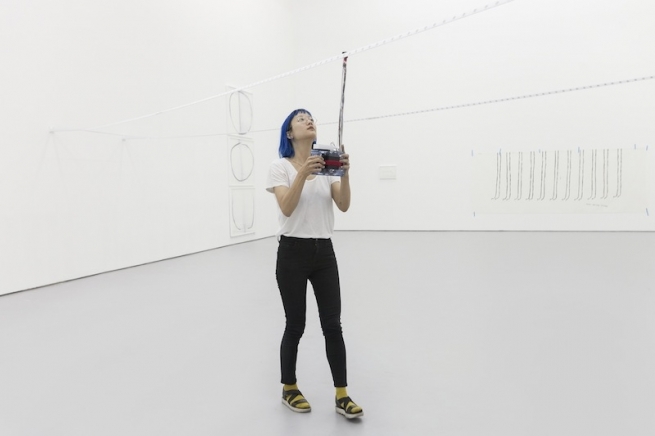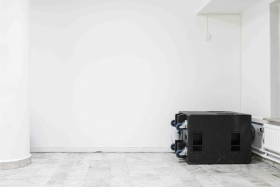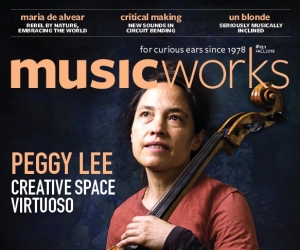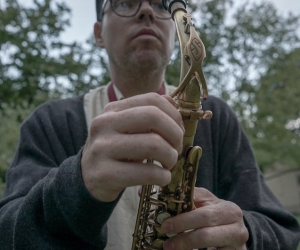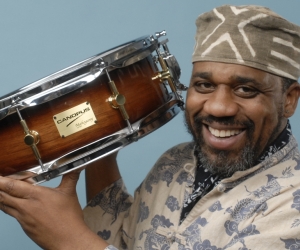“Low frequencies just being abstract and shit — High frequencies be like anal and micromanaging
for no good reason — Silence oblivious as ever”
These words are handwritten in a drawing that was included in an exhibition of new works by Christine Sun Kim in the summer of 2015 at White Space Beijing, a contemporary art gallery in China. The exhibition included a series of charcoal-on-paper works and a sound installation, both offering playful and poetic insights into the American artist’s preoccupation with sound as a form of social currency. In another drawing in that exhibit, the phrase “A friend once described silence as a noise without character — There is a nearness to it” is written below what looks like three empty music staves consisting of only four lines each. The absence of a fifth line (which would normally appear in traditional musical notation) hints at the lexicon within these works, which deploy both the visual traces of American Sign Language (ASL) and basic musical-notation symbols to create a folded space (for example, four lines left by four fingers crossing the paper evoke the physical expression of the ASL sign for “score”).
Christine Sun Kim describes sound as a ghost. There is a nearness to it, its presence is felt, but its aural reality is obscured by her own particular listening conditions: born deaf, Kim moves between modalities of painting, performance, and experimental music in her artistic practice, as she investigates her relationship to sound and her own voice. The work exposes and regenerates our etiquette around sound and listening, and in doing so challenges Kim and her audience to rethink the very nature of sound as a communication medium by redrawing notions of connectivity, trust, power, and otherness in relation to audibility.
Evoking a particular North American history of experimental-music notational practices, Kim’s works on paper playfully oscillate between drawings and scores. Echoing the austere and poetic minimalism of early La Monte Young compositions (such as Composition 1960 #7, the score of which consists of an open-fifth chord and the instruction “to be held for a very long time”), the drawings simultaneously hold overtly political and playful forms that bring to mind the early text scores of Yoko Ono. But while the drawings feel grounded in a well-travelled history of experimental notation, it is their trans-semantic, allegorical, and humorous nature that is most exciting. In the drawing “piano within piano,” [see image above] from her Voice Series (2015), Kim uses the musical notations for quiet dynamics (p and pp) to create an image that has a surprising connection to sound and that resembles a rather happy sandwich. While an understanding of the particularities of each drawing might prove challenging, or even alienating for some, this effect is not without value and is not the result of an oversight. It is this engagement with not knowing—touching on the notion of exclusion, without the intention of producing it—that opens up an interesting space of empathy in Kim’s work.
In what is perhaps an overt response to Kim’s experience of Beijing itself, many of the drawings allude to the ASL sign for the word “future,” turning it over on itself through various semiotic puns. Sometimes feeling like a joke, and in other cases like a call to arms, the drawings are both independent works and a kind of thinkpad for Kim’s parallel performance and installation works. The sense of performative action in the drawings is extended into the accompanying sound installation Game of Skill [image below: Kim interacts with Game of Skill]. Kim asked her audience to listen to a recording of a text she wrote regarding the future of China. The audio was heard through customized handheld listening devices, intentionally designed to make the text difficult to hear. Long strips of Velcro, embedded with magnets, crisscrossed the gallery, which listeners traversed with the listening devices in order to hear the audio playback. In attempting to understand the text, each listener had to find their own way of moving, their own rhythm—hence the title. If one walked backwards, the audio played backwards; if one walked slowly, the audio slowed (its pitch dropped). This intentional complication of communication itself is paradigmatic of much of Kim’s work, which attempts to conjugate one’s everyday listening habits. The political dimension of the installation entered another register, with the realization that the voice in the recording was not actually Kim’s, but that of a friend. Kim refers to this as “leasing a voice,” and indeed it is in this act of employing another to speak for her, to be her voice, that issues of trust and power in the work are heard anew.
It’s not that Kim brought in someone else’s voice out of inhibition; she’s used her own voice in her work in the past. As she wrote in an email, the gesture to make her voice audible is powerful enough on its own: “Giving my voice away for others to hear actually excludes me in a way. It’s like I’m trusting you to take my voice, which is a very similar relationship I enter into with sign-language interpreters.” In her most recent works, however, it is this act of “leasing” the voices of others that makes her communication politics most resonant. For example, in her performance Subjective Loudness, which took place at the Ueno Park Outdoor Stage during the Sound Live Tokyo festival in 2013, Kim asked an audience of 200 people to recite a series of word scores into microphones that sounded through 200 individual speakers. Each score deconstructs a word representing an object that produces a sound with a volume of 85 decibels. As Kim explained in a letter to the audience: “. . . instead of resisting or subverting Ueno’s sound etiquette [a sound limitation rule stipulating nothing louder than 85 dB], together we will attempt to convert the list [of 85 dB noises] into a score; as part of my practice, I will depend on audience participation as my platform, instead of using the actual stage.”
Here the gesture was simple and powerful: by asking us to voice loudness together, to sound these words, the subjectivity of loudness becomes sonic. By asking us to speak for her, Kim points out the complicated politics inherent in the daily supplementation of her voice as a deaf person. “The more I collaborate, the more sonorous my voice becomes,” she explains.
In 4x4, a sound installation presented in January 2015 at Andquestionmark in Stockholm, Kim’s preoccupation with the supplementation of her own voice took on a more poetic and complicated form. Working with texts taken from her drawings, she created four songs and recorded four voices performing them. Each of the voices has some cultural significance in relation to the medium of sound: artist Tony Conrad, musician Matana Roberts, designer Jeffrey Mansfield, and Robert Cohn, the entrepreneur who commercialized voicemail. The playback of these recordings was dispersed in the gallery through four large subwoofers, each turned on its side and placed in one of the four corners of the space. [see image right] The frequency of the recordings was shifted down to below thirty-five Hz (roughly out of the audible range), and each was “tuned” to Andquestionmark’s space. With the audio rendered nearly inaudible, the sheer size of the bass frequencies alone allowed gallery visitors to actually feel the sound. The highly specific tuning process enabled calibrated moments in the recordings to trigger affects arising from the architectural features of the room itself. At the end of each song, a seven-Hz sound made the front window rattle, signalling the beginning of another song. At the end of the entire song cycle, a tone sweep appeared, signalling the finale, which Kim describes as “a short explosion that can be felt everywhere.” In this way, the room itself became an instrument for enacting proximities to the silenced voice of another.
Kim has acknowledged Alvin Lucier’s iconic work I am sitting in a room as a major inspiration for 4x4. Indeed, this work in particular, which literally performs the space with inaudible sounds, strongly ties Kim to a tradition of American experimental composition entrenched in an exploration of psychoacoustics and the social conditions of listening. Like Lucier’s work, which in part uses his own speech irregularities (his stutter) as a creative catalyst for the piece, Kim’s work finds a renewed imaginative space in situating the voice of another within the realm of her own experience of sound. While Lucier engages the room to change his voice, Kim deploys the inaudible frequencies of the voice to act on the room—and in turn the bodies within it. But in doing so, she points to another perhaps more prescient and provocative idea: our reception of the voice of another can attune us to ourselves.
“Your voice is disappearing, into the walls, making the light fittings shiver. The doors move and the windows shake. Your chest fills up with sound, your cranium bubbles. Yet, your ears cannot hear anything. A song is played, you can feel it, but it’s not really there. It could be the artist’s voice, or someone else’s in disguise. Any attempt at speaking is sucked up and absorbed by the surroundings. The inaudible sound is leaking through the building, too big to be detained in the space. The silence is physical, permeating the rooms, the objects, the bodies. It becomes the sound.”
— Stefanie Hessler of Andquestionmark, notes on 4x4
Top image: "piano within piano," charcoal on paper by Christine Sun Kim. Middle image (Game of Skill) by: Yang Chao Photography Studio. Bottom image (4x4) by: Sara Linderoth.
